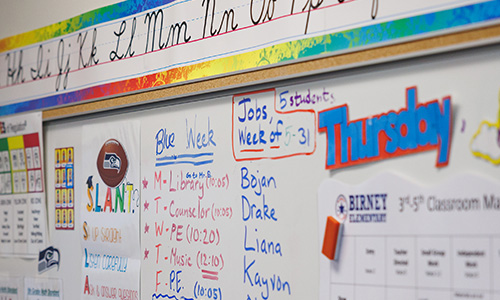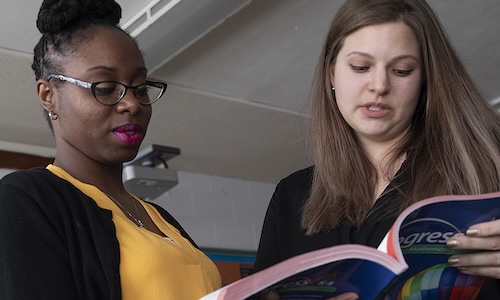 Consider this skill from the fifth-grade Common Core State Standard (CCSS) on powers of ten: “Explain patterns in the number of zeros of the product when multiplying a number by powers of 10.” When taught, this concept usually boils down to the shortcut “When you multiply by ten, just add a zero.” Using precise language in mathematics is critical. This language, however, is problematic.
Consider this skill from the fifth-grade Common Core State Standard (CCSS) on powers of ten: “Explain patterns in the number of zeros of the product when multiplying a number by powers of 10.” When taught, this concept usually boils down to the shortcut “When you multiply by ten, just add a zero.” Using precise language in mathematics is critical. This language, however, is problematic.
What about this shortcut is so troubling? Firstly, the phrase itself is inaccurate. “Adding a zero” to the number 135 gives us 135 + 0, which is equal to 135, not 1,350. (This type of wording can be specifically problematic for multilingual learners too; some research on multilingual classrooms has shown that imprecise terms or lack of consistency in using “transparent terms” limits a multilingual learner’s conceptual understanding of the mathematics.) Secondly, the shortcut doesn’t apply to all number forms. Consider the numbers 135 and 1.35 as an example. If I “add a zero” after the number 135, I get a greater number. If I do the same thing to 1.35, the value doesn’t change.
When students come across these types of obstacles, they are forced to reconcile the limits of the shortcut, which may lead them to memorize two different rules about how the place values work: 1) If I add zeros to the right of the digits in a whole number, I get a greater number. 2) If I add zeros to the right of the digits in a decimal number, the value doesn’t change. Then the rules are tweaked for fractions, exponents, repeating decimals, radicals, and more.
Over time, the list of rules gets longer, and students have to sift back through a catalog of memorized rules to find the one that applies to the mathematical scenario they are wrestling with. All the while, the larger conceptual idea that houses powers of ten (magnitude) gets lost. Sure, students can run the computation and write in the number of zeros the exponent says, but do they really understand the significance of the number’s change in value? Probably not.
Adjusting language to avoid misconception
Some mathematical rules we tell our students expire (both in elementary school and middle school) when the students’ understanding and experience get more sophisticated. Our learners must continually establish mathematical “truths” to later find themselves resolving and relabeling them with conditional statements. Not only is this detrimental to a student’s understanding of mathematics as a whole, but it also disrupts the progression of learning and could very well be part of why people consider math to be so challenging (the “truth” is always changing). When we try to distill a complex and connected idea down to a simple statement that fits the bounds of just one grade level’s expectations for understanding, we neglect to develop the long-term trajectory in building a conceptual understanding of how all the domains of mathematics work together.
Traditionally, the emphasis on language use in mathematics has focused primarily on vocabulary development. But there is research to suggest that scaffolds for multilingual learners that focus only on vocabulary don’t fully equip those students to fully engage in the mathematical discussions. Since discourse is regarded as a best practice and cornerstone of effective twenty-first century mathematics instruction, even more importance can be placed on considering how teachers and students use language in mathematics beyond simple vocabulary acquisition. Fueling opportunities for rich conversation with precise language in mathematics is becoming more important. A recent review of research posits six design principles for instruction to enrich mathematics language use that would be great tools in any teacher’s belt.
Let’s return to the powers of ten example illustrated at the beginning of this article to note specific ways you could use language more precisely to illuminate the mathematics in your classroom and avoid misconception.
Tip #1: Don’t rush to the shortcut
Instructional pacing and the volume of mathematical terrain to be covered in a year often pressure teachers into hurrying students to the shortcut so they can show mastery on an assessment. But there is plenty of mathematics literature to suggest that building a conceptual foundation will lead to stronger understanding if students receive appropriate instruction.
In the powers of ten example, you can focus instruction on understanding “how many times greater” one number is than another with similar bases and differing powers of ten. Additionally, place value holds all manner of patterns beyond the number of digits in a given value. Taking the time to explore both of these together reinforces the idea that powers of ten fit in with a lot of other patterns to be discovered in the magnitude of numbers.
For students who need more support, base ten blocks would help build a concrete understanding of the difference in magnitude between numbers of different powers of ten.
Tip #2: Let students generalize, then be precise
The pattern of the number of zeros in subsequent powers of ten can (and should) still be observed by students. Instead of telling them the pattern, however, allow students time and space to make their own generalizations about it. Then, as a group, work to justify and clarify claims made by your students. This elevated level of ownership of the learning has been shown to increase confidence, proficiency, metacognition, and persistence.
For several years of my teaching career, I’d let students create theories about the patterns they saw in the new mathematical terrain we were exploring. As the claims were tested and approved by the classroom as a whole (not just confirmed by me), we’d name them after a student and put them up on the wall for all learners to use as tools in their math work. To this day, I wonder if the theory that “all even numbers are divisible by two” is still better known as “Liam’s Theory” in those students’ minds.
Perhaps a student’s first attempt at a generalization about multiplying by ten is that we are “adding a zero.” As the facilitator of the conversation, you can encourage students to be more precise (even visually showing what + 0 does to the actual value of the number). Further conversation might reveal a more widely understandable way of stating this mathematical phenomenon, such as “The product has one more zero digit” or, even better, “one more place value” (or, if we are getting really into it, “one more order of magnitude”). In these more precise statements, we’ve removed the concept of “adding” (since we are focused on multiplication by 10) and we’ve clarified “zero” as “a zero digit” or “a place value.”
Tip #3: Connect to the big idea concept
Since powers of ten are deeply seated in the bigger idea of magnitude, it makes sense to put this new learning in the larger context of that connective idea of mathematics. There are many big ideas to understand in mathematics that are crucial to representing the discipline as a connected framework of ideas that build upon each other. In fifth grade, it would be valuable to walk students back through the journey they’ve already taken with magnitude over the years.
Early on, students learned that numbers have value and that those values could be compared to each other. There are basic operations that affect the value of numbers, and those operations build on each other (multiplication is one representation of repeated addition and division for subtraction). Numbers can take on many forms, from fractions to decimals to whole numbers and beyond. Patterns can be found within repetitions of value created by applying basic operations as well; powers of ten (another number form) represents another type of pattern. And the purpose of understanding powers of ten is to understand the relative magnitude of numbers expressed in this form.
Tip #4: Connect to and build upon other mathematical concepts
Before introducing the exponential notation and jumping right to the pattern in the zeros, you could also set the stage by building connections to other concepts of mathematics.
You could have students look at scales on various maps to understand how the distances on the map compare to the real-world distances, for example. They could build out the proper language for describing such a phenomenon, saying something like, “In order to find the real-world distance between two points on the map, I’d simply scale up the map distance using this scale factor.” You could also talk about scale models for things like cars and trains, which hold a scale factor. Then, when entering the realm of powers of ten, students can understand multiplying by a power of ten as scaling the original value. The language could immediately become more precise because students won’t automatically gravitate toward an inaccurate statement like, “We add a zero.” They can incorporate the connected idea of scale factors to say something like, “We scale up the value of the number by one power of ten.” (Notice this language also gives us really healthy grounding in that bigger idea of magnitude as well.)
Alternatively, you could start more concretely by having students express each power of ten as a multiplicative series (for example, 25 × 103 = 25 × 10 × 10 × 10). This would be particularly helpful for comparing two values with the same base, such as 25 × 103 and 25 × 105. Seeing that the difference between these two expanded forms is a series of two factors of ten (and how that is represented in the exponential form, expanded form, and standard form) can help students understand the relative magnitude of each value. Not only is this a great connection back to expanded form, but it lays significant groundwork for conversations about prime and composite numbers (which could be expressed as a series of factors) on into prime factorization and greatest common factor (where students would be carrying out the same process of using expanded form to find the total value both numbers have in common).
Precise language in mathematics is a core facet of teaching
As a teacher, I was a stickler for precise language, often making students rephrase their thinking to bring more clarity to their arguments. While this prompted the occasional groan, students were better equipped to defend their thinking and work proactively to find the clearest way to present an idea to a peer or the class. But the benefits of precise language go beyond clear expression of ideas. Research has demonstrated how improving the quality of language use in the classroom also raises individual understanding and conceptualization.
In many cases, using precise language in mathematics can actually illuminate the mathematics itself, making the scenario or interaction between ideas more accessible. Using precise language also positions students to keep their eye on the big picture. Instead of focusing on the steps of the single process or specific rules for a mathematical interaction, students can use clear arguments to show their understanding of how that process or rule could fit into the larger realm of a big idea like magnitude, equivalence, or proportionality.
Encouraging, modeling, and prompting precise language in mathematics with your students will also support their development of key mathematical practices like constructing viable arguments or critiquing the thinking of others. This impacts more than just mathematics, as these skills are transferable to their informational and persuasive writing, interpretation of information from various sources, and ability to identify bias and faulty reasoning.
Possibly the most powerful reason precise language in mathematics instruction is crucial is to avoid creating misconceptions. I encourage you to try out all or some of the tips I’ve shared here and observe how doing so supports your students in getting a more complete understanding of the math you’ve been entrusted to teach them.





